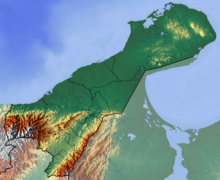
Mihrab is a niche in the wall of a mosque that indicates the qibla, the direction of the Kaaba in Mecca towards which Muslims should face when praying. The wall in which a mihrab appears is thus the "qibla wall".

The Mosque–Cathedral of Córdoba, officially known by its ecclesiastical name of Cathedral of Our Lady of the Assumption, is the cathedral of the Roman Catholic Diocese of Córdoba dedicated to the Assumption of Mary and located in the Spanish region of Andalusia. Due to its status as a former mosque, it is also known as the Mezquita and as the Great Mosque of Córdoba.
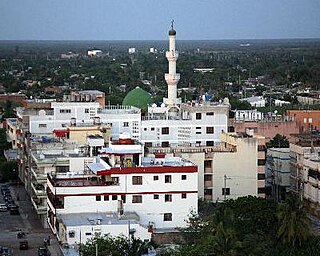
Maicao is a city and municipality in the Department of La Guajira, northern Republic of Colombia. It is located 76 km from Riohacha, the capital of the department and is the second largest urban center near the border with Venezuela, after the city of Cúcuta.

The Emirate of Córdoba or Umayyad Emirate of Córdoba was a medieval Islamic kingdom in the Iberian Peninsula.
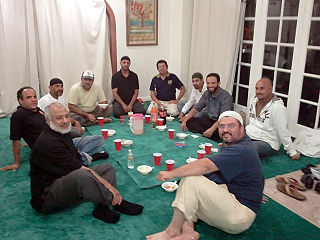
Mexico is a predominantly Christian country, with adherents of Islam representing a small minority. Due to the secular nature of the state established by Mexico's constitution, Muslims are free to proselytize and build places of worship in the country. The country has a population of around 126 million as of 2020 census and according to the Pew Research Center, the Muslim population was 60,000 in 1980, 111,000 in 2010, and is predicted to be 126,000 in 2030; however, according to the 2010 National Institute of Statistics and Geography (INEGI) census, there were only 2,500 individuals who identified Islam as their religion. Most Muslims are foreign nationals and the majority are Sunni.

Islam in Colombia is a minority religion, with most Colombians adhering to Christianity (Catholicism). According to a 2018 study conducted by Pew Research Center, the size of the Colombian Muslim population ranges from about 85,000–100,000 people out of a total population of 50.4 million. However, according to official estimates the Colombian Muslim community numbered just 10,000 people or 0.02% of the total Colombian population. Most Colombian Muslims are immigrants from the Arab World along with a small number of local converts.

Moorish architecture is a style within Islamic architecture which developed in the western Islamic world, including al-Andalus and what is now Morocco, Algeria, and Tunisia. Scholarly references on Islamic architecture often refer to this architectural tradition by a more geographic designation, such as architecture of the Islamic West or architecture of the Western Islamic lands. The use of the term "Moorish" comes from the historical Western European designation of the Muslim inhabitants of these regions as "Moors". Some references on Islamic art and architecture consider this term to be outdated or contested.

The Mosque of Cristo de la Luz is a Catholic chapel and former mosque in Toledo, Spain. It is the one of the ten that existed in the city during the Moorish period. The edifice was then known as Mezquita Bab-al-Mardum, deriving its name from the city gate Bab al-Mardum. It is located near the Puerta del Sol, in an area of the city once called Medina where wealthy Muslims used to live.

The Masjid al-Qiblatayn, also spelt Masjid al-Qiblatain, is a mosque in Medina believed by Muslims to be the place where the final Islamic prophet, Muhammad, received the command to change the Qibla from Jerusalem to Mecca. The mosque was built by Sawad ibn Ghanam ibn Ka'ab during the year 2 AH and is one of the few mosques in the world to have contained two mihrabs in different directions.
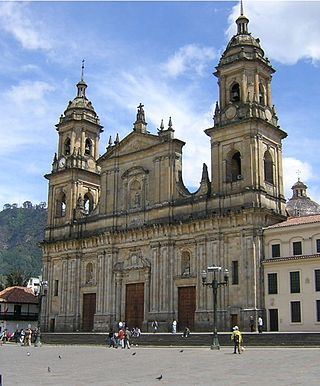
Religion in Colombia is dominated by various branches of Christianity and is an expression of the different influences in the Colombian culture including the Spanish, the Native Amerindian and the Afro-Colombian, among others.
Mosque of Omar, Masjid Umar, Masjid-e-Umar, Al-Omari Mosque or Mosque of Omar ibn al-Khattab is a name given to many mosques, usually referring to Omar, a companion of Muhammad and Caliph (579-644) recognized by Sunni Muslims in the succession to Muhammad. Masjid is the Arabic word for a place of worship, commonly translated as mosque in English.

The Mezquita de las Tornerías is a Moorish former mosque in Toledo. It was built in the middle of the 11th century on the foundations of Roman architecture, located in the old Muslim neighborhood Arrabal de Francos. Currently it houses the "Center Foundation of Promotion of the Crafts", that can be visited and hosts temporary exhibitions.

The Islamic Cultural Center "Custodian of the Two Holy Mosques King Fahd in Argentina" is a mosque and center for Islamic culture located in Buenos Aires, Argentina. It is named after King Fahd of Saudi Arabia.
The Al Farooq Omar Bin Al Khattab Mosque is a mosque located in Dubai, United Arab Emirates. The mosque is named after Umar bin Al Khattab, a companion of the Prophet Mohammed who became the second Caliph after Abu Bakr and was given the title Al Farooq, meaning someone who distinguished truth from falsehood. The original Al Farooq Omar Bin Al Khattab Mosque was established on the same site in 1986.

The Al Ahmad Mosque is an Islamic place of worship in Buenos Aires, Argentina, opened in 1985. It is the second oldest mosque in Buenos Aires but it is the oldest building with Islamic architecture in Argentina and it was designed by Ahmed and Elia Ham.
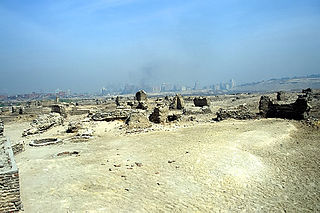
Amṣar, refer to civilised cities and large areas in which houses, markets, schools and other public facilities are located. The plural form also sometimes referred to 'garrison towns' or structures that were established by Muslim warriors in conquered lands, in the first centuries of Islam. The first were created under Caliph Omar during his reign from 634 to 644 AD. Many of these garrisons attracted civilians and became towns.
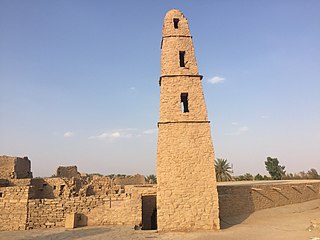
The Mosque of Umar Ibn al-Khattab is a historic mosque in Dumat al-Jandal in northern Saudi Arabia, located adjacent to the Marid Castle. It is one of the oldest mosques in the north of the Arabian Peninsula and is considered one of the important monuments in Al-Jawf and in Saudi Arabia in general.

The Mexuar is a section of the Nasrid palace complex in the Alhambra of Granada, Spain. It served as the entrance wing of the Comares Palace, the official palace of the sultan and the state, and it housed various administrative functions. After the 1492 conquest of Granada by Christian Spain the building's main hall was converted into a chapel, though many of the Christian additions were later removed during modern restorations. The palace's two main courtyards were also put to other uses and only their foundations remain visible today.
